Introducing Paul Trammell
Paul Trammell’s life is a testament to the pursuit of adventure and a deep connection with nature.
Growing up in Charleston, West Virginia, Paul discovered his love for the natural world early on, a passion that eventually led him to Florida Institute of Technology, where he studied biology and began his journey as a surfer. Paul has explored various career paths, from teaching to carpentry, always seeking new challenges and experiences.
In 2015, a pivotal decision to quit drinking transformed his life, reigniting his love for adventure and leading him to the world of sailing. Over the years, Paul has penned multiple books chronicling his journeys and experiences, including his near-death encounters and the serene beauty of remote islands. Now, as he sails around the Caribbean on his boat, Windflower, Paul combines his passions for sailing, surfing, and spearfishing, continually seeking new stories to tell and new horizons to explore.
Tell us where you are in the world right now, and what a typical day looks like for you.
I am in Bocas del Toro, Panama, and I have been in Panama for a little over a year now. I’ve sailed around the area, exploring places like Isla Escudo de Veraguas, Laguna de Bluefield, Rio Chagres, and Portobello, but I have spent most of my time around Bocas. This place has me captivated with its good surf, spearfishing, calm anchorages, and services in town. I also love the variety of culture here, particularly the Ngäbe indigenous tribe. They live all over the Caribbean coast of Panama, and often stop by in their dugout canoes to sell lobster, fish, empanadas, bread, pipas, bananas, or platanos.
During the surf season, a typical day is up an hour before the sun, coffee, yoga, drive my dinghy in the dark to a pointbreak five miles away, arriving at sunrise, and surf for three or four hours. When there is no surf, I often spearfish.
I also work at my computer full-time (unless the surf is good) writing and podcasting. Every morning, I do a half hour of yoga on the foredeck of my boat, followed by twenty minutes of meditation. I often start in the dark and experience the sunrise while I stretch and meditate. I also try to catch the sunset every day.
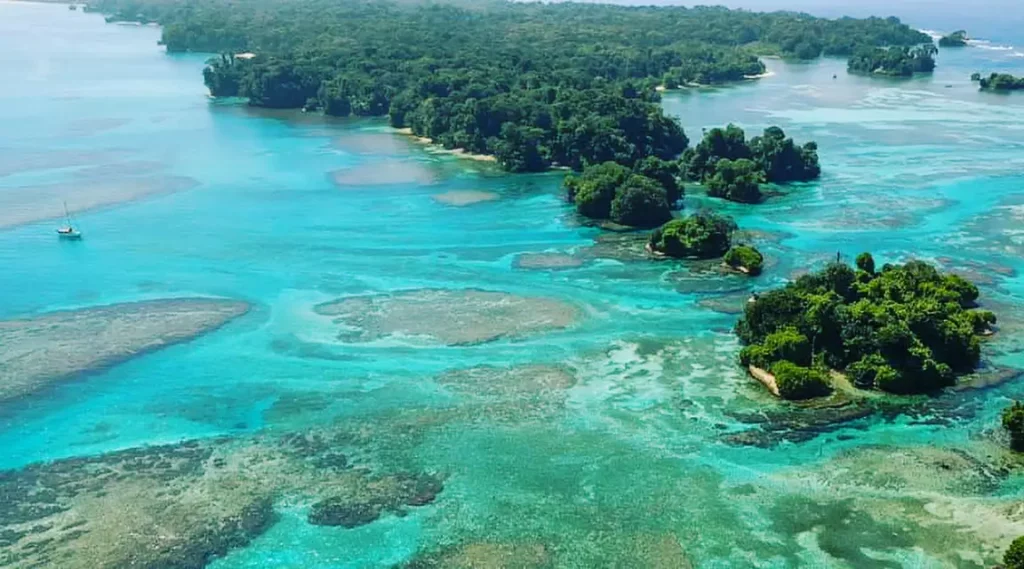
First Encounters with Sharks
I don’t remember the very first time I spotted a shark, but it would have been while surfing, and that is always scary, because after you see a fin, it disappears, and you don’t know where the shark is and your imagination takes you to dark places.
It’s much less scary to see one while diving, in clear water, and then you can see that they generally are ignoring you or acting wary of you.
I was terrified of sharks for a long time. Now, I am used to seeing them while diving, and as long as they don’t bother me, it’s not too scary, and I continue with whatever I’m doing.
If one sticks around while I’m spearfishing, I won’t go after fish, but will take a lobster. If one swims toward me, I’ll stand my ground and maintain eye contact until it leaves, then I’ll go somewhere else.
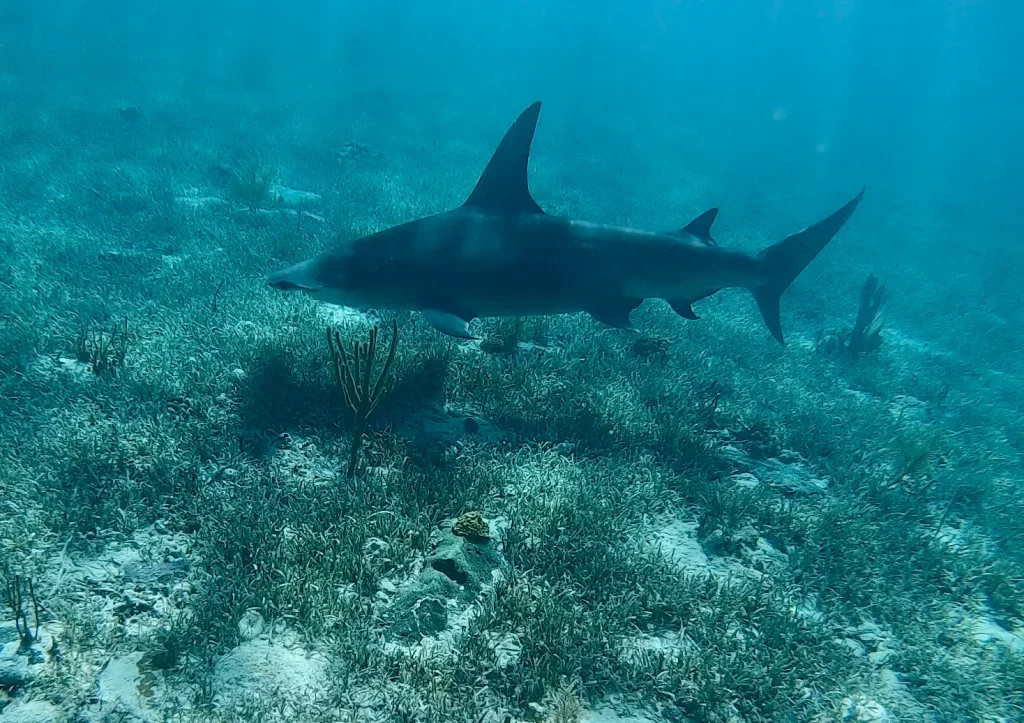
Safety Rules for Surfing and Spearfishing
What safety rules do you have for yourself while surfing?
Regarding sharks, almost none. They aren’t a threat here in Panama. They are common in Florida, but we still don’t see them often.
There’s not much to do as far as safety when surfing.
I have been advised by a shark expert not to surf around fishermen or piers where people fish. But the waves are often best at a pier, and surfers generally don’t shy away from anywhere with good surf.
Sharks leave us alone almost all the time, and attacks on surfers are rare. I’ve been surfing since 1988 and in all that time, two of my friends have had something cut them on the leg or foot, but no definite shark bites.
What safety rules do you follow while spearfishing? After you catch a fish and bring it back to your dinghy, do you make sure to hunt in a different spot?
In Panama, I don’t think about sharks too much, because I rarely see them.
In The Bahamas, where I see them often, I am more careful. I keep my dinghy very close, sometimes tied to my wrist on a fifty-foot rope.
After spearing a fish, I take it straight back to the dinghy, and while swimming back, I like to hoist it out of the water.
If the fish is too big to hoist out of the water while swimming, I put a knife in its gills. This makes them stay still. The thrashing of a fish attracts sharks. They can hear it. They’ll smell the blood much later, but they hear the sound instantaneously.
Any sign of a shark, and I will go somewhere else after spearing a fish.
In the Bahamas, I’ll go somewhere else anyway, usually. If I have a buddy, it’s best if we alternate dives and watch each other. If one of us spears a fish and a shark shows up, the person watching gets between the shark and the person with the fish.
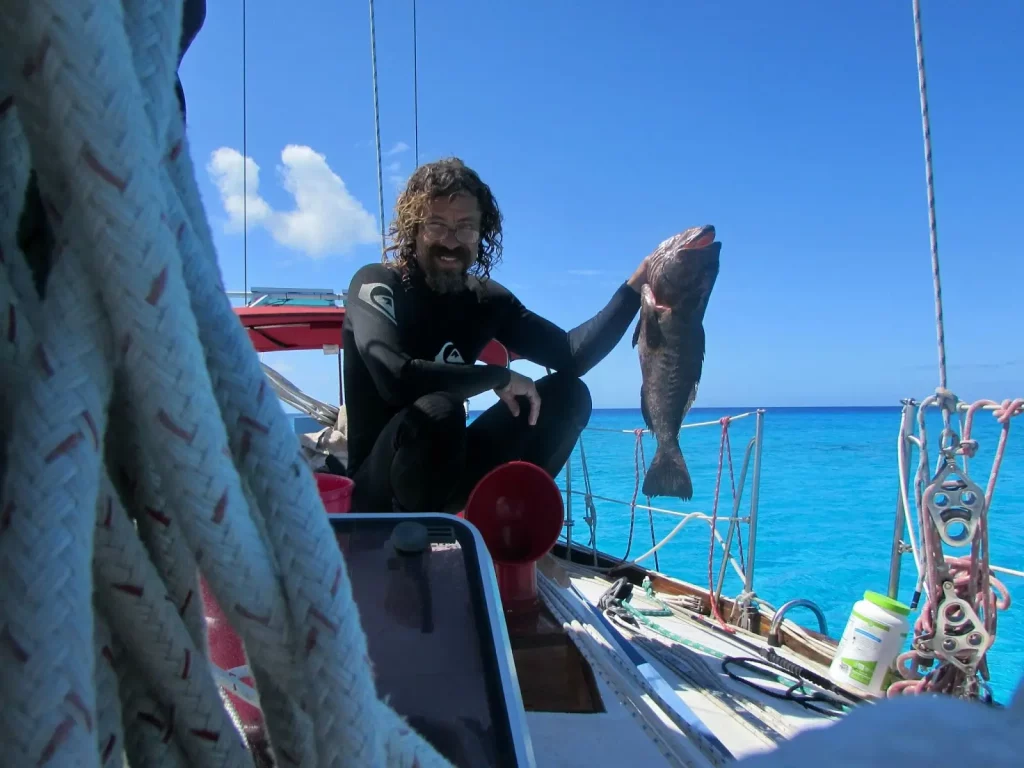
Understanding Shark Species and Behaviors
Are there certain shark species you don’t worry about encountering? For example, nurse sharks or reef sharks, even though they can be interested in your catch too?
Nurse sharks are harmless and don’t count as a shark sighting, and they don’t cause me to alter my behavior in any way.
Reef sharks, blacktips, and lemon sharks are not particularly aggressive, but can be dangerous if excited by a fish on a spear.
Bulls and tigers are to be avoided at all costs. Oceanic whitetips are the most dangerous in the tropics (I’ve yet to encounter a great white) but I did encounter an oceanic whitetip. I was on a paddleboard and it bumped me four times, and I pushed it away with my paddle each time. I thought I was going to die, but it eventually left.
Hammerheads are not particularly dangerous and they are bizarre and magnificent, almost like seeing an alien spaceship underwater.
Do you feel safer when spearfishing because you have a weapon and are underwater at their level?
Yes. It helps to have something in hand to hold out and fend a shark off with. I’ve only had to do that once, but I often point my spear at sharks that are getting too curious, or barracudas that I want to leave.
Have you ever had to defend yourself by putting your fins in a shark’s snout, using your spear or board?
No, just the spear that I almost touched a bull shark with, and pushing the oceanic whitetip with the paddle.
But I have had to stare sharks down, or swim toward them many times. Swimming toward them works well. They don’t like it. Sharks, overall, are very careful not to get injured and are wary of humans.
Views on Shark Deterrents
Shark deterrents like Sharkbanz and those designed for surfboards are available. Have you ever tried them? Why do you think they aren’t more popular, considering they could significantly reduce risks for surfers?
I don’t know anyone who has tried anything like that. We don’t worry about sharks. Maybe surfers do in other places, but not anywhere I’ve ever surfed, which includes Florida, The Bahamas, Panama, Chile, Costa Rica, El Salvador, and Mexico… Of all the people surfing every day, shark attacks are extremely rare. But they make a good news story, so we often hear about them.
You’re from Florida, a known hotspot for shark encounters and shark bites. Do you think people there are more fearful of sharks but also more knowledgeable about how to prevent shark bites?
There’s little for a surfer to do to prevent a shark bite, besides not splashing excessively, panicking, and acting like an injured fish, which nobody does.
Spearfishermen need to know about them and know how to act, but surfers, not so much. However, it’s important never to run away from any predator. If a surfer, or anyone sees a shark, it’s important to sit still, or group together, but not to splash or run away.
In some parts of the world, such as Australia, they deploy nets for miles along the shore to protect the beaches. Would that make you feel safer while surfing?
I don’t know. I’ve never even thought about it. That would be impossible in Florida, and nets tend to trap fish and turtles and generally harm sea life. I’d be against it if it was proposed near me.
Living On The Edge
Some people love spending time in nature, fully immersing themselves in the elements. But others take it even further by seeking solo experiences, and you are obviously in that category.
Does this connection to your primal instinct and the experience of being in potentially life-threatening situations result in a deeper respect and appreciation for nature?
Yes, definitely. Living close to the edge is life-expanding. Seeing danger and the potential to die makes life much more vivid and meaningful. I almost drowned once in a shallow-water blackout. I went to the other side and came back, and the experience changed my outlook on life and death forever.
Life is dull when it is always safe and artificial, and people feel this but don’t understand it, so they try to spice life up with alcohol, drugs, gambling, excess comfort, entertainment, affairs, etc. Living more exposed to the natural world and adding adventure to your life is a better solution.
And also, does it make you develop a higher tolerance for danger?
Yes. I have always enjoyed the thrill of a bit of danger, and I’ve learned that the best things in life involve risk. I expose myself to a lot of danger surfing and spearfishing and sailing, but I also try to not take unnecessary risks.
For instance, I always wear a lifejacket with a built-in harness and tethers when I sail offshore, and am usually tethered to the boat. I’m also much less afraid of dying since my near-drowning experience. I now feel like I won’t die until it’s my time to die.
I believe that for most people, swimming with sharks or marine megafauna (such as rays and whales) has the potential to evoke very powerful sensations that would also lead to a deeper appreciation for nature.
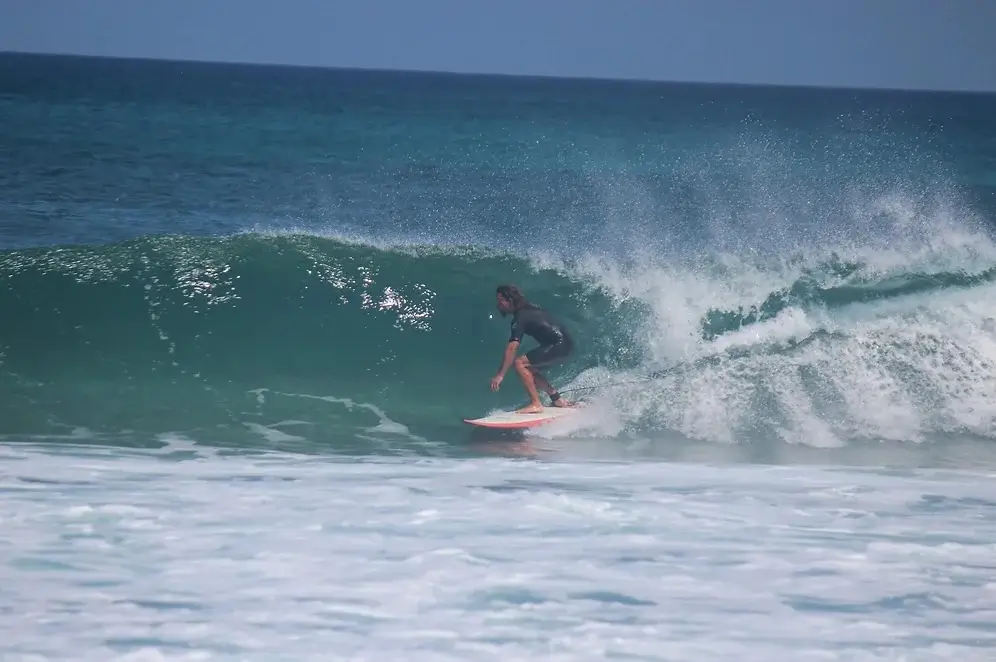
Impact of Marine Life Encounters on Conservation Perspectives
How do you think these powerful experiences with marine life impact people’s perspectives on ocean conservation and marine ecosystems?
People who live in nature appreciate it and are more apt to want to make sacrifices to preserve it.
Those who live in artificial worlds – in man-made environments – tend to not understand why nature is important or care about conservation as much.
Nature is a system that supports life. We can’t survive without it, and there is no planet-B for us to go colonize. This is it. Earth is the only planet we have, and we have to assume it is the only planet we will ever have.
” Regardless, spending time in nature makes it clear that nature has infinite intrinsic value. It’s ridiculous to destroy it for short-term profit, and so rich people can get richer. That is a crime against all the people of today and of the future “
Can you share any personal stories or observations about how swimming with sharks or marine megafauna has influenced your own connection to nature?
Every sighting of a large sea creature is a memorable experience. I once swam with a school of large spotted eagle rays in The Bahamas.
I saw them as large intelligent animals, as majestic creatures just cruising casually along the edge of a reef, which is exactly what I was doing. We were out doing the same thing. I saw their faces, and made eye contact, and saw their bodies that are suspended below the wing, and the large knife-like barbs they use for defense.
I’ve had whales come up to my sailboat as if to say hello. I’ve come across large black bears in the forest on my bike. I’ve seen huge turtles in the water, and even one that was asleep. It’s all magnificent and reminds us that we are not the only important animals on Earth. It’s not “our” planet, and we are visitors in the ocean.
What advice would you give to someone who wants to have a meaningful and respectful encounter with these creatures?
It might take a lifestyle change to interact with large animals in the wild. The key is to spend time in nature regularly. Get to know the nature that is accessible to you. Observe all you can, and remember that the small creatures are just as interesting as the big ones.
Overall, I’m all for human/nature interaction. If someone wants to take a guided tour to see whales, go for it. Even going to an aquarium or zoo is better than simply ignoring animals and nature. But the best is to immerse yourself in nature as deeply as you can, and to quietly observe while you are there.
One great side benefit of spearfishing, I think, is that it makes you learn about fish and marine life. One needs to be able to identify what they see and learn about their behavior and habits. When spotting a shark, I find it more frightening not knowing which type of shark it is.
Do you feel safer if you know the species, like knowing it’s a nurse shark or a lemon shark?
Absolutely. It’s useful to be able to identify everything in the ocean – sharks, fish, invertebrates, different jellyfish, etc.
When you know what something is, you can predict its behavior, or know if it’s poisonous, or aggressive, or a warning of something else. Certainly some sharks are more threatening than others, as I discussed above.
Handling Shark Encounters
A freediver woman from South Africa, Zandile Ndhlovu, recounted encountering a large bull shark while freediving off Cape Town’s coast. She said that with bull sharks, it’s a staring contest—you must remain calm and keep facing them.
Have you had similar experiences?
Yes. A bull shark harass me in The Bahamas while I was spearfishing once. I had to keep my eye on it, and keep facing it, and point my spear at it. It made a few passes and swam towards me once. I did not have my dinghy with me, which was a mistake. My sailboat was about 300 yards away. I held my ground until the shark gave me a chance to get away.
It made a pass at me, and then was moving in the general direction I wanted to go, so I followed it. The shark looked back at me, saw me following behind and above it, and it took off. I continued at the same pace back to my sailboat.
You must have been in pretty hairy situations at times, such as the weather suddenly changing and your boat dragging towards the reef, coming up from a dive and realizing your dinghy is drifting, getting injured while surfing, or being followed by sharks interested in your catch.
Can you recall some of these situations and what happened?
I’m very careful about anchoring the dinghy while spearfishing, and haven’t had the anchor fail.
However, a few years ago, I was swimming in The Bahamas, towing the dinghy with its small anchor in my hand and my GoPro in and spear in the other hand. I was more scared of sharks then than I am now.
I noticed something coming on my left and when I looked, a large hammerhead swam right by me in the opposite direction, only fifteen feet away. I dropped the anchor and turned on the Go Pro. I got a good video of the shark, and since it continued without even acknowledging my presence, I just continued swimming.
About ten minutes later, I began to feel vulnerable and wanted to get back in the boat, but realized I was not carrying the anchor. When I looked up, I saw the boat far behind me, anchored where I saw the shark. I had to swim all the way back, which, after seeing the large shark, was very uncomfortable.
Another time while spearfishing with friends, and watching each other’s backs, I saw a triggerfish and followed it to a cave, found it, and speared it. I took it to the surface, swam to the dinghy, and climbed aboard. My friends then swam up and said, “Did you see the sharks?”
“No, I didn’t see any sharks,” I replied.
He went on to tell me that four followed me to the cave with the fish, and my friends got between the sharks and me. That made me realize that sharks are probably on the scene much more often than I am aware of.
Another time, I speared a grouper in the Bahamas, took it right to the boat and put it in the bucket. When I got back in the water, a large reef shark was right there close to the boat looking at me. I got back in the boat and went somewhere else.
Observing Changes in Marine Environments
Have you returned to spots you have dived before and noticed a drop in fish population, coral health, and marine life in general? How did that make you feel?
Absolutely. I dove in The Bahamas in 1991 quite a bit, and the coral was alive and vibrant and looked like an urban metropolis of fish and invertebrates. It was magnificent, like a Van Gogh painting.
I returned and dove on the same reefs 25 years later and they were mostly dead. Now the reefs look like a bunch of rock with algae growing on them, and just a few fish, and spare bits of live coral. It’s an armageddon going on now and will make you cry if you think about it too much. The vast majority of the coral in The Bahamas (and the Caribbean in general) is dead. This is an entire ecosystem dying, like a desert forming where there was once a vibrant and productive jungle.
Future Plans and Adventures
What’s next for you? Are you preparing to sail to different shores or getting ready for the upcoming surfing season? (I have no idea if it is…) Any exciting plans or projects you’re working on?
July and August is the “mini surf season” here, so I am enjoying it. I might stay here this winter again for the main surf season, or I might go to The Bahamas. I do plan to visit the San Blas islands sometime this year, and I will surely go to Escudo de Veraguas again.
It’s a magical island inhabited only by a few Ngäbe who live there seasonally to fish. It’s surrounded by reef and is one of the most beautiful places I’ve ever seen. In fact, it is surely the most beautiful and serene tropical place I’ve seen.
I don’t have any big ambitious voyages planned, but have been enjoying staying in one country for the last year. I spent the last four on the move, and knocked out a bucket-list destination two years ago – Newfoundland. That was the biggest adventure of my life, and the subject of my book “Sailing to Newfoundland.”
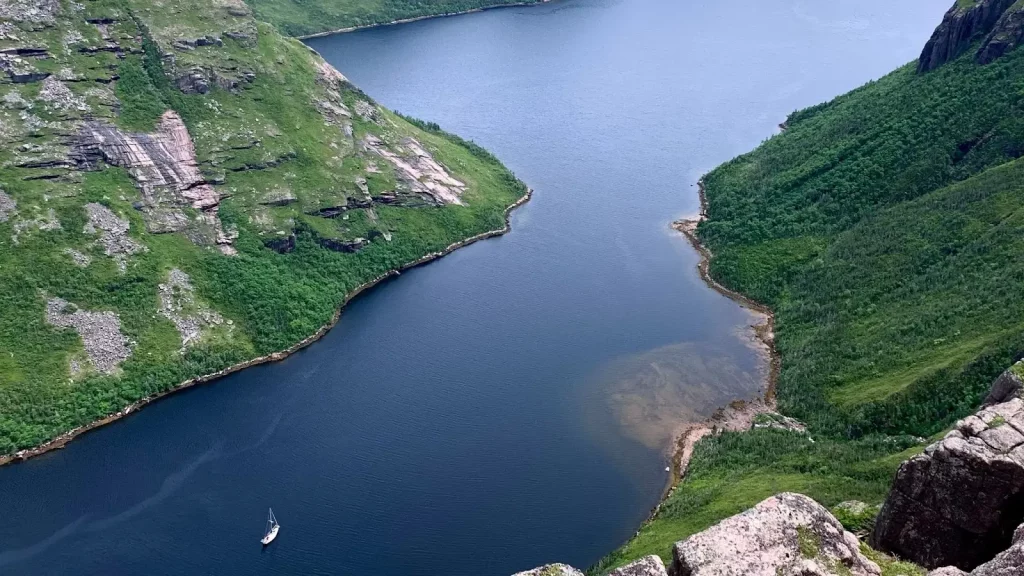
My new bucket-list destination is Patagonia. I would like to sail through the Straits of Magellan or the Beagle Channel, then up through the channels of Chile and into the Pacific.
Thank you so much for giving us an insight into your world. Your stories and expertise are truly fascinating and inspiring.
Paul Trammell
Paul Trammell’s books are available at Amazon, Barnes & Noble, and as audiobooks.
Check his podcast, Offshore Sailing & Cruising for great offshore sailors interviews and insights on sailing solo.